Crucial P1 NVMe SSD Review: QLC Flash Gone Mild (Updated)
Why you can trust Tom's Hardware
1000GB Performance Results
Comparison Products
We put the 1TB Crucial P1 against a few very competitive options. Of course, we have the Intel SSD 660p that has the same components and is basically the same drive. We also have the Plextor M9Pe, Samsung 970 EVO, WD Black, Adata XPG Gammix S11, and MyDigitalSSD BPX Pro. These represent most of the mainstream NVMe options available. We also threw in the Crucial MX500, a SATA drive, to gauge the performance of the more expensive NVMe products.
Trace Testing – PCMark 8 Storage Test 2.0
PCMark 8 is a trace-based benchmark that uses Microsoft Office, Adobe Creative Suite, World of Warcraft, and Battlefield 3 to measure the performance of storage devices in real-world scenarios.


The P1’s first result is rather alarming. The P1's total score of 4970 points and the average bandwidth of just 301MB/s is nearly the same as the best SATA drives. In fact, despite its faster NVMe connection, the P1 barely outperforms the SATA MX500. The P1's NVMe-based competition, however, scores much higher.
Game Scene Loading - Final Fantasy XIV
The Final Fantasy XIV StormBlood benchmark is a free real-world game benchmark that easily and accurately compares game load times without the inaccuracy of using a stopwatch.

Most flash-based drives load the StormBlood benchmark in 21 to 22 seconds. The Crucial P1 scores the lowest total time of 21.97 seconds, but the difference between the fastest and slowest flash-based SSDs is slight. In either case, it's clear that any SSD is much faster at loading games than any HDD.
Transfer Rates – DiskBench
We use the DiskBench storage benchmarking tool to test file transfer performance with our own custom 50GB block of data. Our data set includes 31,227 files of various types, like pictures, PDFs, and videos. We copy the files to a new folder and then follow up with a read test of a newly-written 6 GB file.


If you want to transfer a bunch of files of various sizes, the Crucial P1 can handle that without a problem. It isn’t the fastest drive in the test pool, but the 288MB/s average in our copy test is respectable. The Crucial P1 is very similar to the 660p during our read test, reminding us that these drives are built from the same basic building blocks.
SYSmark 2014 SE
Like PCMark, SYSmark uses real applications to measure system performance. SYSmark takes things much further, however. It uses fourteen different applications to run real workloads with real data sets to measure how overall system performance impacts the user experience. BAPCo's SYSmark 2014 SE installs a full suite of applications for its tests, which includes Microsoft Office, Google Chrome, Corel WinZip, several Adobe software applications, and GIMP. That also makes it a great test to measure the amount of time it takes to install widely-used programs after you install a fresh operating system.


The Crucial P1 installed SYSmark in 15 minutes and 32 seconds, outperforming the WD Black and the Intel 660p by nearly a minute. The Crucial MX500, however, was six seconds faster. After the SYSmark run, the Crucial P1 scored 1600 points in the responsiveness test. On its own, that is almost three times faster than an HDD. But the SSD competition is faster, including the SATA-based MX500.
ATTO
ATTO is a simple and free application that SSD vendors commonly use to assign sequential performance specifications to their products. It also gives us insight into how the device handles different file sizes.
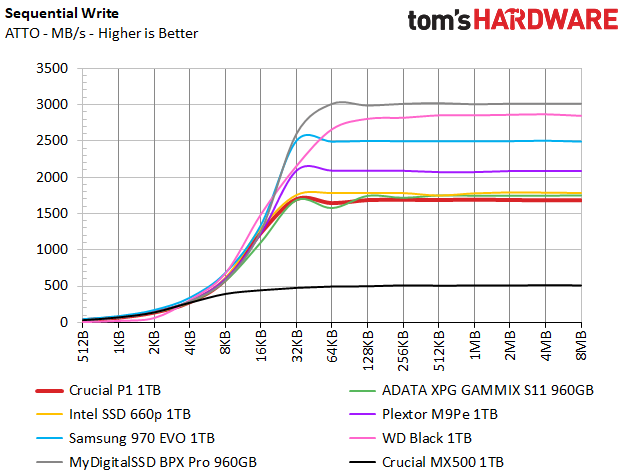

The MyDigitalSSD BPX Pro takes the overall win in this test. Once again, the Crucial P1 is very similar to the Intel 660p, though it does have higher read performance and slightly lower write throughput. We do see the advantage of the NVMe interface in this test, though: The P1's read and write throughput are three to four times faster than the SATA-based MX500.
Anvil's Storage Utilities
Anvil's Storage Utility is a commonly-referenced benchmark that simplifies the complex IOMETER benchmark and its underlying Dynamo engine with a one-click software wrapper.


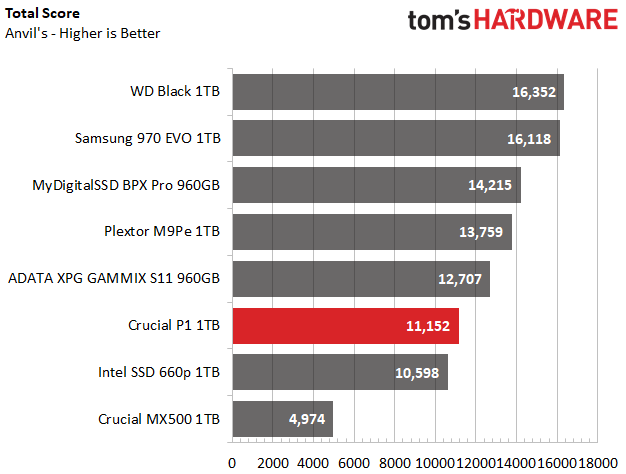
The Crucial P1 outperforms Intel 660p, but lands in sixth place overall. The P1's slower sequential performance lands a tier below some of the other mainstream competitors.
CrystalDiskMark
CrystalDiskMark (CDM) is a simple and easy to use file size benchmarking tool.
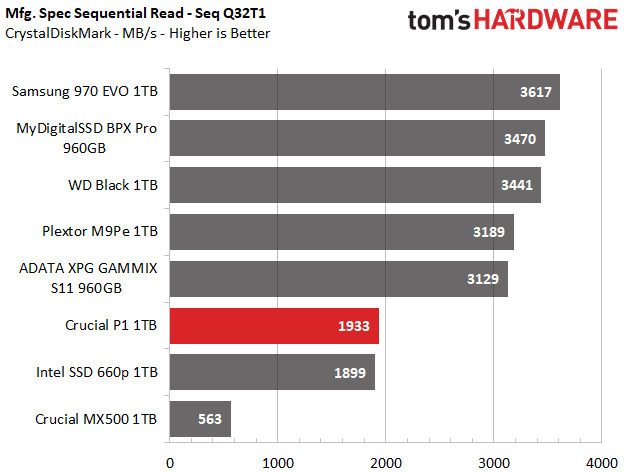




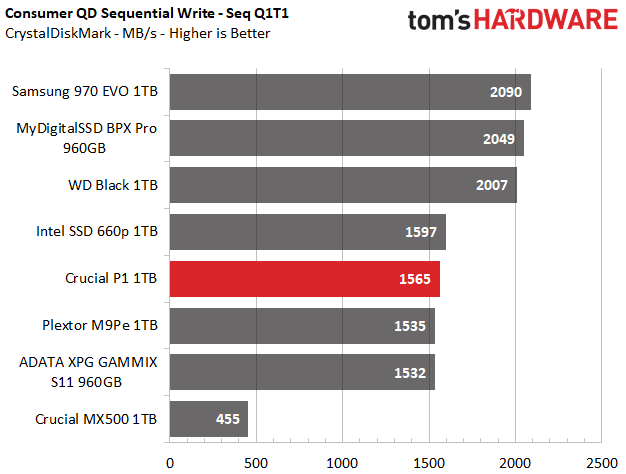


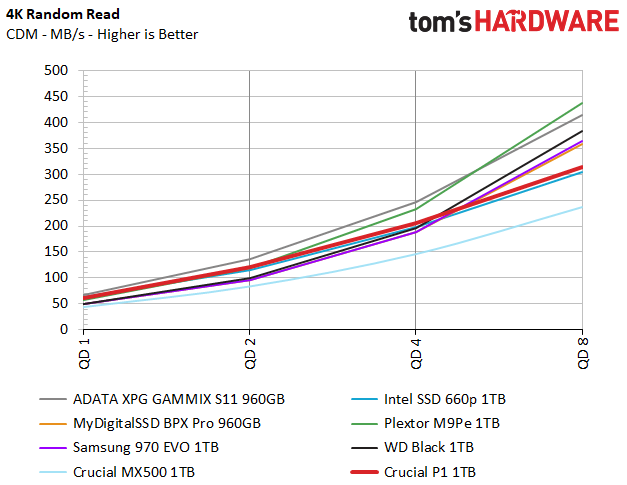

Crucial’s P1 exhibited strong 4K random performance at a QD (Queue Depth) of 1. The drive is also strong in the all-important QD 1 to 4 range. It also meets its QD32 specification, but this heavy workload is irrelevant for most desktop file transfers.
Sustained Sequential Write Performance
Official write specifications are only part of the performance picture. Most SSD makers implement an SLC cache buffer, which is a fast area of SLC-programmed flash that absorbs incoming data. Sustained write speeds can suffer tremendously once the workload spills outside of the SLC cache and into the "native" TLC or QLC flash. We hammer the SSDs with sequential writes for 15 minutes to measure both the size of the SLC buffer and performance after the buffer is saturated.


The Intel 660p is faster than the P1 for the first 20 seconds of this heavy write workload, but after that, the P1 took the lead until the buffer was full. Crucial’s P1 wrote 149GB of data before its write speed degraded from 1.7GB/s down to an average of 106MB/s. Overall, this is an impressive result in a worst-case scenario, but you won't be able to take advantage of the P1's full write speed unless you're transferring files from an equally fast storage device.
Power Consumption
We use the Quarch HD Programmable Power Module to gain a deeper understanding of power characteristics. Idle power consumption is a very important aspect to consider, especially if you're looking for a new drive for your laptop. Some SSDs can consume watts of power at idle while better-suited ones sip just milliwatts. Average workload power consumption and max consumption are two other aspects of power consumption, but performance-per-watt is more important. A drive might consume more power during any given workload, but accomplishing a task faster allows the drive to drop into an idle state faster, which ultimately saves power.
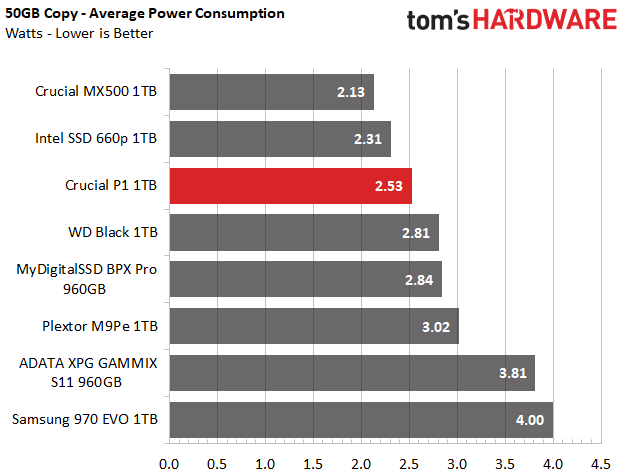




The P1 consumed just under 700mW with ASPM disabled, and just barely 11mW after we enabled the feature.
| Row 0 - Cell 0 | Rating | Measured |
| ASPM Disabled | 800mW (Max) | 686mW |
| ASPM Enabled | 80mW (Max) | 11mW |
| Max Power Consumption | 8W | 3.91W |
The P1 consumed an average of 2.53W of power during our 50GB file transfer. That's slightly more power than the MX500, but you get almost twice the performance in exchange. The P1 also had the lowest maximum power consumption. The P1's efficiency measurement of 114MB/s per watt is also plenty impressive, but Intel's 660p is slightly better.
MORE: Best SSDs
MORE: How We Test HDDs And SSDs
MORE: All SSD Content
Current page: 1000GB Performance Results
Prev Page QLC Flash Gone Mild Next Page 500GB Performance ResultsStay On the Cutting Edge: Get the Tom's Hardware Newsletter
Get Tom's Hardware's best news and in-depth reviews, straight to your inbox.

Sean is a Contributing Editor at Tom’s Hardware US, covering storage hardware.


